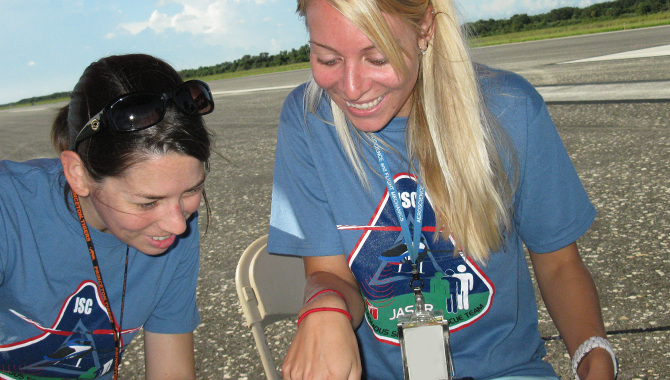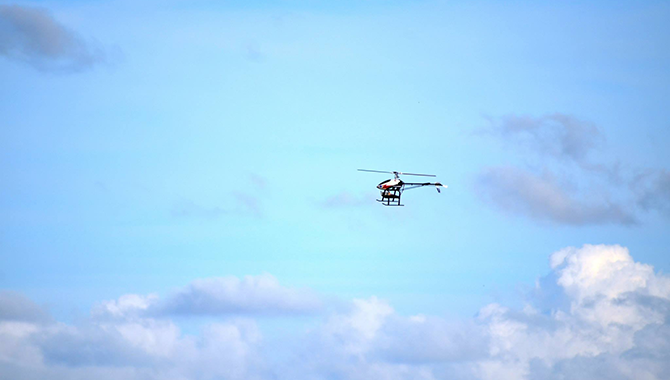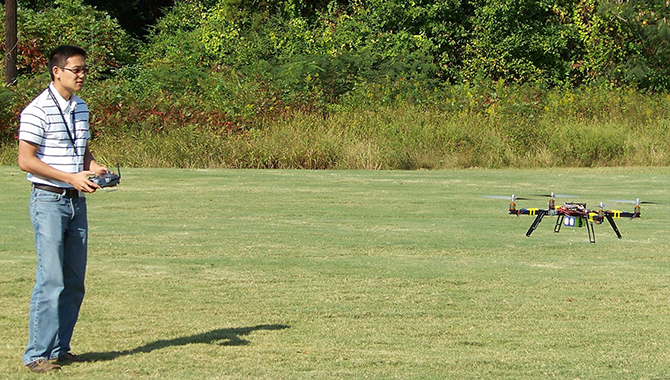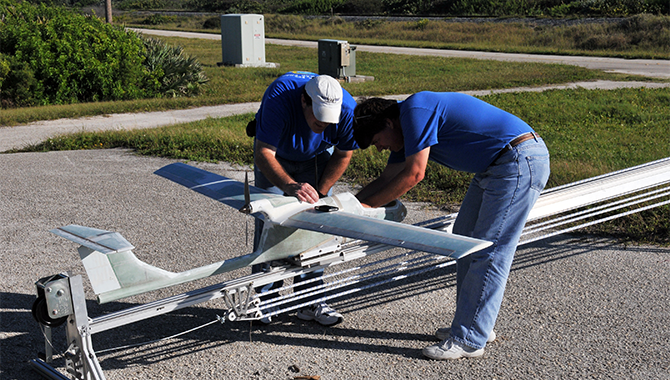
The Johnson Autonomous Search and Rescue (JASAR) competition team built upon existing capability with their remote control (R/C) helicopter, but had to pave the way for flying their unmanned aerial system (UAS) at their center.
Johnson Space Center’s Engineering Directorate leadership wanted their young engineers to be more involved in writing flight control software. The Rocket University UAS Competition offered a low-cost opportunity for their early-career engineers to gain this kind of hands-on experience. Among the engineers from Johnson’s Aeroscience and Flight Mechanics Division selected for the team were Mark Kane (flight software and autopilot functionality), Sara Scarritt (navigation system), and Rebecca Johanning (image processing).
The team chose to fly a T-Rex 700 R/C helicopter, building upon previous work done with the vehicle at JSC. Mike Goza, an engineer developing Robonaut 2 (R2) currently aboard the International Space Station and a certified R/C helicopter pilot, served as the team’s mentor and vehicle pilot.
As the team embarked on their yearlong competition experience, they encountered a number of challenges, chief among them navigating the regulations and processes for flying a UAS at their center. Despite the hurdles, the team achieved a better understanding the regulatory infrastructure and worked within the system to successfully fly their vehicle. The competition serves as a tremendous learning experience that continues to this day.
(Editor’s note: The following are excerpts from a series of interviews conducted with the Johnson Space Center competition team members and mentor. Some of the content has been edited for clarity and readability.)
APPEL News: One of the biggest challenges for your team was navigating the processes for air traffic control at your center. Can you tell us more about this?
Rebecca Johanning: Basically, there was no system in place yet to fly our unmanned aerial system on JSC property. There is a private flying club that comes onsite and they can fly all of their remote control helicopters without any problem. However, when flying government equipment, we had to go through the Federal Aviation Administration and Houston air traffic control and work with them to put together the procedures to fly. Everyone on the team had to get certified as either a pilot or an observer. Then when we wanted to fly, we had to get on the aircraft flight schedule, the same schedule that all of the jets are on at Ellington Field.
We had our first official flight the week before we left to go down to Kennedy, so it was pretty much down to the wire to get everything done and all of our certifications completed so we could fly. At one point we almost had to back out. It was pretty hectic.
APPEL News: So is it fair to say that the process has become a little more relaxed or at least streamlined since your team got started?
Sara Scarritt: I would say more streamlined, not necessarily more relaxed. We have figured out how to work within the system now and know what we need to do.
APPEL News: Mike, I would imagine during your career at NASA, you’ve encountered challenges similar to what the team experienced. As the team mentor, what sort of guidance did you give them?
Mike Goza: Hang in there. (Laughter.) It will eventually get solved. It’s just a matter of time, but it did put a damper on the competition itself because they had developed these algorithms and we couldn’t test them. Now after the competition, we’re actually going to start up again and continue the work.
We’ve been able to fly now when we want. We have to tell them that we want to fly on such-and-such date at a certain time period. We have to go through some of the hoops, but those are fine. We can handle those. We don’t have to go through the initial process of being allowed to fly anymore. We have permission now and we’re hopefully going to start flying every other week to test this hardware and develop the algorithms.
APPEL News: Tell us about the day of the competition. What was it like?
Mark Kane: I actually wasn’t there on the day of the competition. I ended up going for the first day for the set-up. We did the practice and the Flight Readiness Review. It was really neat to go down there, meet the other teams we were going to be competing against, and see what their solutions were and how we went about solving the same problem. At JSC we took our R/C helicopter and developed all of the software and image processing pretty much from the ground up. Kennedy ended up building a plane from scratch. Marshall ended up using a lot of off-the-shelf stuff and combining it all together. So it’s neat to see all of the different approaches.
Scarritt: I definitely enjoyed it. It was neat to see all of the systems do what they did. Like Mark said, it was really interesting to see what the different teams focused on and what their process was. You could almost see the mentality of each team in how they approached the project. All of us are Guidance Navigation and Control (GN&C) engineers, so our focus, like Mark said, was the flight software, the automation, getting all of that up from scratch and designing and proving it ourselves. Kennedy does more assembly, so they built their plane from scratch and focused less on the software side, I think. I think the Marshall team focused more on the management and the systems engineering processes, and less about the hardware and software.
Kane: And to be fair, our management really wanted us to go from the ground up. In GN&C we do a lot of work in simulation so it was really neat to get our hands on the hardware and figure out how do you really implement it, how everything works when you get delayed, and trying to make sure everything communicates properly between each other.
Scarritt: We really were trying to stick to the larger goals of our division, since they were the ones who purchased the helicopter in the first place. I think it worked out really well, but being able to go and see other teams, see them fly, and have that competition was an added bonus. It pushed us to spend a little more time and work a little faster because this wasn’t our primary project. We all have other things to work on. It can be easy to let something like this slip, but I think the competition really gave us a focus and a timeline.
APPEL News: Rebecca, what was flight day like from your perspective?
Johanning: It was a little stressful actually. We got there and we were getting our helicopter together and realized that a little adaptor plug was missing.
Scarritt: Oh, I’d forgotten about that.
Johanning: The plug that we needed to connect the batteries to the flight computer. We were kind of scrambling to rewire some things so we could get power to our only autonomous system, which was the image processing. So that was a little stressful because we’re sitting there and Mike is doing the rewiring and we’re counting the minutes down to when it was our turn to fly. But we finally got that sorted and Mike flew our helicopter around. We were just taking images. We didn’t get to see anything in real-time because we couldn’t really stream the live camera footage to the ground. We finished the flight successfully and we got done processing the images and looking at them, and I was ecstatic that you could pick out the mannequins.
I had done testing, you know, laying clothes down on the ground, going up high and taking pictures, getting NASA co-ops to lay on the ground and take pictures of them. But to see the actual images of the mannequins and having those be identifiable was really cool. I’m pretty sure I screamed at one point and cheered.
APPEL News: What are some lessons learned you gained from the project experience?
Scarritt: I would say start early. That was the big thing we learned. And not just on the technical stuff. We’re all engineers, so we dove into the technical side of things and what our technical responsibilities were for the helicopter. On the bureaucratic side, I don’t know that anybody was chasing it that closely until it became an issue. So I guess from the standpoint of what goes on in establishing the groundwork for how we’re going to do the tests even if we’re not quite ready to do them yet. I don’t think anyone had thought about it. We wanted to get all of our software, hardware, everything ready to test and just didn’t really realize that there were going to be bureaucratic hurdles as well.
Johanning: Yeah, I agree with Sara. Definitely start early. At the beginning of the project, they basically promised that we could do whatever we wanted. It was going to be quick and easy, we could go out every single day and fly a new system if we wanted to. It obviously didn’t turn out that way. So there was a lot to learn about how the risks associated with small aircraft like that, but obviously aircraft operations wanted us to be safe and do things the right way.
For the technical stuff, I loved that it was really hands-on. Within my first week of getting to NASA, I was already working on the project, so it was really fun to be able to dive into it. I was really the only one working on the imaging system, so it was kind of up to me. Basically, I could do what I wanted, so that was really neat.
APPEL News: Mike, as the pilot for the aircraft and team mentor, what do you think are some of the big takeaways during the competition?
Goza: The biggest one is that if you’re going to fly something, start early. In terms of the mentoring side, the highlight for me was when Rebecca, who did the image recognition, the visual part of it—because part of the competition was you had to find people laying on the ground, mannequins in various clothing—the best thing for me was when we flew over it, we came back over to the table, she looked at the data, and her algorithm actually found every single mannequin every time. She let out a squeal. She was able to find the mannequins. If we had had all of it automated we would have been just fine.
Because we couldn’t fly the system really beforehand (we couldn’t test anything), I had to remote pilot it the entire competition. That was a disappointment because we really would have liked to do the whole thing autonomously. The nice thing is that we’re being allowed to continue working on it, so we’re going to get that part working.
APPEL News: Now that you have gone through the competition, are there different experiences or opportunities that you’d like to take advantage of?
Kane: For my part, the main thing is just to get it flying. Instead of just designing a controller and doing a lot of flight software, this is the first thing that I’ve actually made fly myself, so that’s kind of the main goal right now. To get it stable. And then I know that the division wants to take a look at autonomous rendezvous and docking. I think in the future, it would be kind of neat to see all of the same teams compete again and maybe build on top of the competition. If something like that was offered, we have all of this groundwork now, maybe we can do something more complex with it or take it back and try to enhance what we’ve done.
Scarritt: I would agree with that. I would love to do the competition again even with slightly different objectives, something to just go meet up with the other teams again. Once we’ve got the automation running a little more streamlined, running a little more smoothly, we have an actual ground station that’s still—I don’t even know if I can call it a work in progress—something that we hope to have to be able to control it from an actual ground station and not just the R/C controller. Also, I’m kind of competitive and I want to go back and spend some time on this to win the competition. I think we have a lot of ideas about what we’d like to do with this and our management would like to see us do with this. I think we’ll all continue to work on it.
Johanning: I know for me, I would like to put some different types of cameras on there. Instead of just a regular optical Web cam, maybe a thermal camera, or a LIDAR camera. You know, put something else besides optical and see what else we could get.
APPEL News: What value do you think programs and competitions like Rocket U bring to the agency?
Goza: I see it as hugely beneficial because the scale of it is small and you get to do the whole gambit of each process. You start off with the classical problem definition, you brainstorm how to solve it, you start taking out hardware and developing software, and then the worst part of all of it, integrating it all together to make it work. It’s also the fun part. And then actually seeing it occur.
A lot of people will go their whole career and never get to do an entire integration like that on a project. They won’t see the whole picture. Whereas these are small scale enough that you can see the entire picture and get a hands-on perspective.
Read an interview with Marshall Space Flight Center’s competition team.
Learn more about Rocket University.
Click to view full photo gallery on Flickr.
After the JSC team finished their first flight, team members Sara Scarritt and Rebecca Johanning review their results and are thrilled to see that the image processing algorithm correctly identified one of the targets.
Featured Photo Credit: NASA / Johnson Space Center









